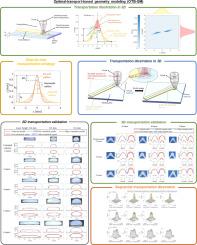基于最佳传输的材料挤压增材制造几何建模
IF 6.8
1区 工程技术
Q1 ENGINEERING, MANUFACTURING
引用次数: 0
摘要
材料挤压增材制造越来越多地应用于汽车、航空航天和医疗行业,因为它能够以低成本创造复杂的特征。尽管具有很高的灵活性,但用材料挤压法制造的零件仍然存在几何不精确和尺寸不稳定的问题,特别是在需要高几何保真度的制造结构时,例如那些具有复杂内部通道的结构。为了提高材料挤压过程的精度和稳定性,介绍了基于制造参数的几何建模方法。研究人员利用物理模型和神经网络来预测打印部件的几何形状。然而,物理建模往往具有复杂性高、计算量大的特点,而神经网络需要大量的测量数据,导致实验成本高。现有几何预测方法的高计算负荷和测量数据需求阻碍了它们在工业环境中的广泛采用,因为它们导致了令人望而却步的长时间模拟和无法支持实时过程优化。为了缩小研究差距,我们提出了一种基于最优输运的材料挤压系统几何建模(OTB-GM)方法。提出的OTB-GM模型通过最小化运输过程中的能量消耗来模拟运动喷嘴对产生最终挤压轮廓的熨烫效果。OTB-GM首先在熨烫之前初始化轮廓,类似于高斯分布的形状。在构建模型时,我们考虑了材料的粘性阻力、重力势能的变化以及熨烫过程中表面几何形状的变化。我们分别推导了二维(2D)和三维(3D)的OTB-GM公式,用于模拟稳态(如线)和动态(如角)挤压条件。为了验证所提出的OTB-GM方法的建模精度,分别对直线件和角件进行了二维和三维打印验证。与传统的椭圆几何建模方法相比,所提出的OTB-GM在二维和三维验证案例中都具有更高的精度。本文章由计算机程序翻译,如有差异,请以英文原文为准。

Optimal-transport-based geometry modeling for material extrusion additive manufacturing
Material extrusion additive manufacturing is increasingly adopted in the automotive, aerospace, and medical industries for its capability to create complex features at low cost. Despite high flexibility, parts fabricated with the material extrusion method continue to suffer from geometric inaccuracies and dimensional instability, particularly when manufacturing structures that require high geometric fidelity, such as those with intricate internal channels. To enhance the precision and stability of the material extrusion process, geometry modeling methods based on manufacturing parameters have been introduced. Researchers have employed physical models and neural networks to predict the geometry of printed parts. However, physical modeling is often characterized by high complexity and significant computational demands, while neural networks require a substantial amount of measurement data, resulting in a high cost in experiments. The high computation load and measurement data demand of existing geometry prediction methods prevent their widespread adoption in industrial settings, as they lead to prohibitively long simulation times and the inability to support real-time process optimization. To close the research gap, we propose an optimal-transport-based geometry modeling (OTB-GM) method for the material extrusion system. The proposed OTB-GM models the ironing effects of the moving nozzle for generating the final extruded profile, by minimizing the energy consumption of the transportation process. The OTB-GM begins by initializing the profile prior to ironing, resembling the shape of a Gaussian distribution. In constructing the model, we take into account the material's viscous resistance, changes in gravitational potential energy, and modifications to the surface geometry during ironing. We derive the formula of OTB-GM in two dimensions (2D) and three dimensions (3D) for modeling steady (like line) and dynamic (like corner) extrusion conditions, respectively. To validate the modeling accuracy of the proposed OTB-GM method, the straight line and corner parts are printed for 2D and 3D verification, respectively. Compared with the conventional ellipse geometry modeling method, the proposed OTB-GM reaches higher accuracy in both 2D and 3D validation cases.
求助全文
通过发布文献求助,成功后即可免费获取论文全文。
去求助
来源期刊

Journal of Manufacturing Processes
ENGINEERING, MANUFACTURING-
CiteScore
10.20
自引率
11.30%
发文量
833
审稿时长
50 days
期刊介绍:
The aim of the Journal of Manufacturing Processes (JMP) is to exchange current and future directions of manufacturing processes research, development and implementation, and to publish archival scholarly literature with a view to advancing state-of-the-art manufacturing processes and encouraging innovation for developing new and efficient processes. The journal will also publish from other research communities for rapid communication of innovative new concepts. Special-topic issues on emerging technologies and invited papers will also be published.
 求助内容:
求助内容: 应助结果提醒方式:
应助结果提醒方式:


